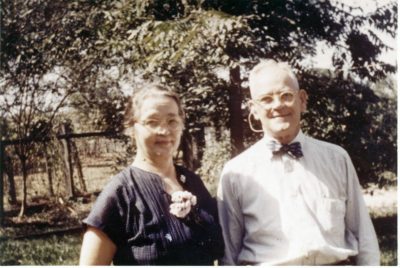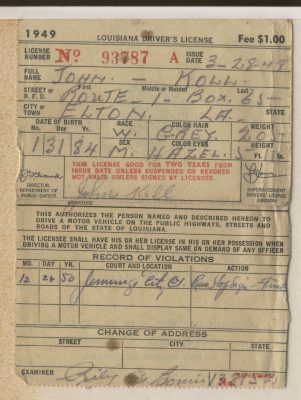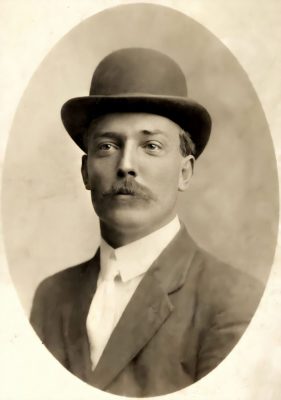
Mee Maw and Pee Paw circa 1956
I had a realization yesterday. And it seems like something I should have noticed earlier. It seems like I talk about it all of the time. And I’m sure my dad must have talked about it too. As you all know, my Mee Maw and Pee Paw were related to each other. They were first cousins once removed. If you don’t like removing people, Robert Joseph Landry, Sr. married his first cousin’s daughter Germaine Erie Patureau.
“So they were cousins,” you say, “what’s the big deal?” Maybe that’s not what you’d say, but growing up in our family that seemed to have been the attitude. People have a different attitude now. “Cousins who kiss now are parted” is the line from my musing on the situation a few years ago. But it’s not just that they are related – and here is the big realization – everyone that is/was related to Pee Paw is/was related to Mee Maw.
Think about that. You have cousins from your mom’s side and from your dad’s side. Most of the time the two sides are not related to each other. And if you happened to be married to your 2nd cousin (heaven forbid!) you would share one of your four sets of great grandparents. That would still leave three quarters of your ancestry different from your partner.
But in my grandparents’ case, it’s a bit more entangled than that. Pee Paw’s father was the brother of Mee Maw’s grandfather. So Pee Paw’s paternal grandparents were Mee Maw’s great grandparents. That takes care of half of Pee Paw’s ancestors- they are also Mee Maw’s ancestors. With the maternal side of Pee Paw’s family it was a generation further back. As a tool, I’ll use the chart that my dad made of all of his ancestors in a circular pedigree chart. Many of you will recognize it from the many times he talked about family history at reunions and get-togethers. Maybe some of you listened more closely and have already heard about this ‘realization’ that I’m trying to explain.

My dad’s genealogy chart.
If you look at the chart with its helpful color coding, you can barely see a dotted green outline on the lower left quadrant (that I shaded green). That is the ancestry that I was just talking about – ancestors of Simon Alcide Landry. It matches with the right side (Mee Maw’s side) starting at due east (on the right) down to southeast (shaded green to match). Those are the ancestors of Jean Trasimond Landry (Alcide’s brother and Mee Maw’s grandfather). These are the common ancestors that make them first cousins once removed.
Alcide was married to Marie Celeste Leveque, whose parents were Auguste Leveque and Basalite Landry. Both Auguste and Basalite had a sister that were ancestors of Mee Maw. Therefore Auguste’s parents and ancestors (shown in the tan color section) are also ancestors on Mee Maw’s side of the family. You can see the peach section repeated on her side on the lower right side. This represents the Leveque connection and they were second cousins twice removed due to this connection. But then Basalite’s parents and ancestors (shown in the yellow sections) are also on both sides of the family. This is another Landry connection and Mee Maw and Pee Paw were second cousins once removed due to this connection.
So, like I said earlier, all of Pee Paw’s relatives are/were relatives of Mee Maw as well. The reverse is not true, though. Mee Maw has a few distinct family lines that are not included on Pee Paw’s side. Mainly the Patureau line that came from France in the 1840s. It’s difficult to find someone related through just the Patureau line, because in our family there were three generations in a row that married into the Landry line, which is what brought us to the situation we now have.
The other distinct line leads back to another Landry. We get our last name from Rene “the younger” Landry and he shows up several times from all of the intermarriages. But Rene “the older” only shows up once. His daughter didn’t believe in marrying cousins. Imagine that! But alas, Rene “the older” really isn’t the only connection to the Landry line he represents. There is another member of that Landry line that we descend from – his sister Antoinette. Somehow that is not surprising.
In the second paragraph of this post I referred to a poem that I wrote a few years ago. I thought I’d post my whole poem here for the sake of those who had not seen it before. It explains (in a way) how I am my own third cousin once removed. I wrote this on June 24 & 25, 2005 when my obsession at the time was limerick writing.
Me, Myself and I
My third cousin once removed did
Take over my life and then hid.
He’s inside my head
But if he were dead,
It would kill both my ego and id.
You see that third cousin is me.
I’ve climbed around my family tree.
I must be part monkey
Or just info junkie,
I swing through the branches with glee.
Some interesting things I discover.
The lines of descent I recover
Appear more than twice.
Well, isn’t that nice.
At least I am not my own brother.
It seems that my grandfather wed
His first cousin’s daughter and bred.
For they had eight kids
And one of them did
Wed mom and you know where that led.
It must have been Cajun tradition
Or kids with a lot of volition.
Whatever the cause,
It didn’t give pause.
It happened despite admonition.
I am my own fifth cousin too.
And no I don’t live in a zoo.
But all this inbreeding
And some genes repeating,
Should lead to a head number two.
And then I’d have room for my cousins.
I know there’s at least a half dozen.
Though they are all me,
I’d set a few free,
Cause we are not kissin’ but fussin’.
We fight over who gets to drive
Who’s out first when we all arrive.
Who gets the last piece,
Who pays on the lease,
It’s worse than most husbands and wives.
I wonder how all this got started,
Cause cousins who kiss now are parted.
To stop a mutation
Or my situation
Where cousins blame me when they’ve farted.
Of course they have done much worse things,
Like knocking that boy from the swings.
They kicked my dear sister
And stole that transistor.
What mischief these cousins can bring.
But one is the absolute worst
It’s him that I mentioned at first.
I’m sure it was him
That burned down the gym.
When mom asked us why, he just cursed.
I guess he’s the strongest, cause he
Is closest relation to me.
He’s really quite tiring
And gets me perspiring.
I wish he’d get lost in my tree.
Hello, it’s ol’ third cousin here.
I’m here to bring fun and good cheer.
Ignore boring Van.
He’s spineless and bland.
With a “Boo” he just runs off in fear.
He blames me for everything bad.
But accidents happen. So sad.
If I don’t come out
And rampage about,
In a very short time I’ll go mad.
Who cares if I mock the deceased?
Or my share of work is the least?
At times I relent,
But I won’t repent.
I’ll laugh if you call me a beast.
(Shut up. Now get back in your place.)
Forgive me for that show of face.
He looks just like me
But as you can see,
He’s lacking in wits, style, and grace.
And now I must leave you alone.
A state that I never have known.
So check out your tree,
Particularly
To reveal who’s in your skin and bones.
























